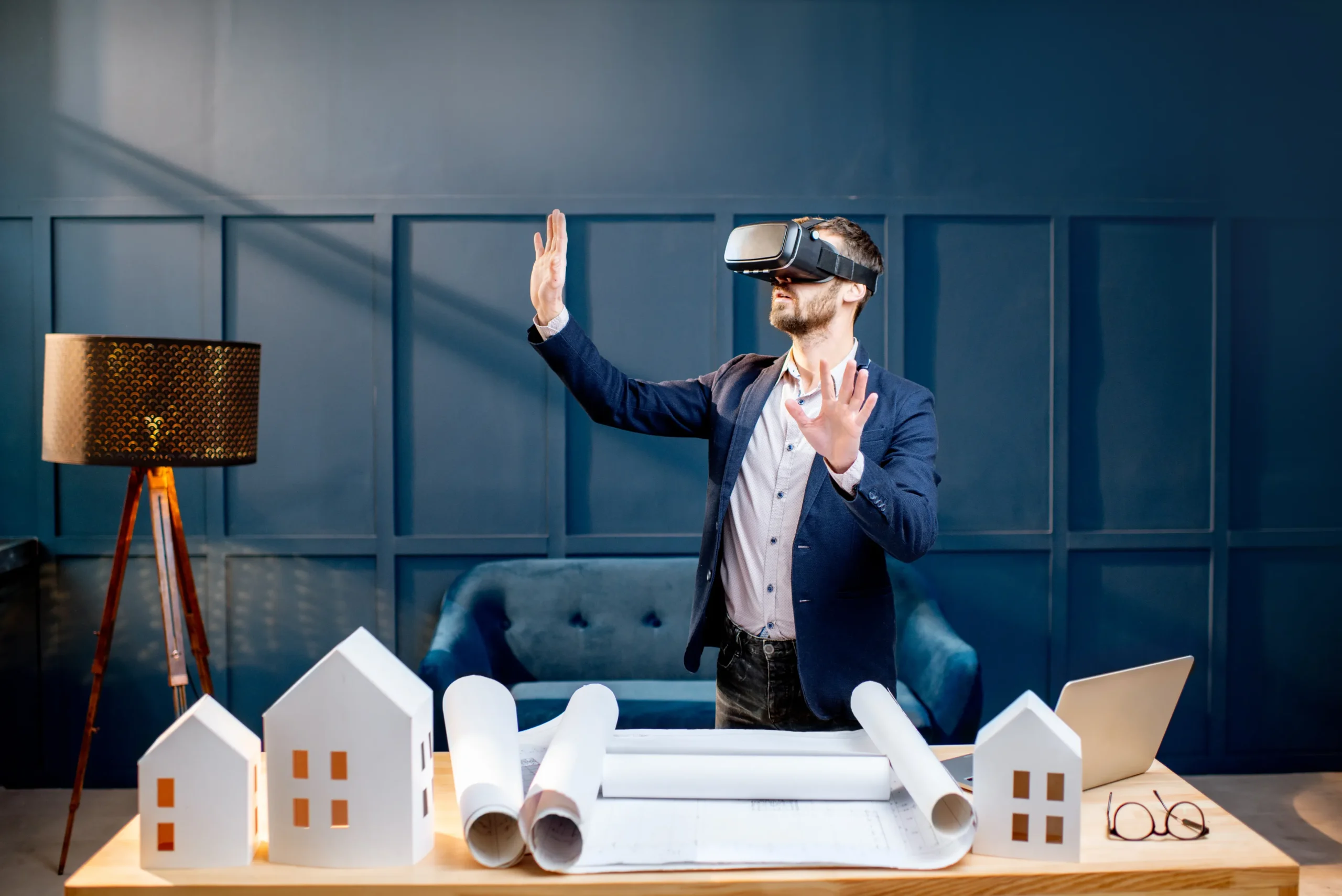
Welcome to a world where creativity meets innovation, where the boundaries of imagination are stretched beyond conventional limits. In the ever-evolving realm of interior design, technology has emerged as an artistic enabler, allowing designers to weave their visions into reality with unprecedented precision and flair. Our journey begins here – a journey into the realm of "3D Visualizations and Beyond Exploring Cutting-Edge Interior Design Tools."
Gone are the days when interior design relied solely on sketches and swatches; a new era has dawned, where pixels and polygons collaborate to shape spaces. As we embark on this exploration, envision the scene: a client stepping into their dream home before it's even built, traversing hallways bathed in virtual sunlight, running their fingers across the fabric of virtual sofas, all while the architect's vision unfolds before their eyes. This is the power of 3D visualizations – a symbiotic dance between artistry and technology, where dreams are no longer confined to the realm of imagination.
Our quest delves deep into the annals of history, tracing the trajectory of interior design from the artisan's hand to the digital realm. We'll unravel the transformative influence of technology, from the advent of Computer-Aided Design (CAD) to today's photorealistic renderings that blur the lines between the physical and the virtual. But this journey isn't just about the past; it's a glimpse into the present and a window into the future.
In this interconnected world, the embrace of cutting-edge tools is no longer a choice but a necessity. We'll introduce you to a myriad of tools that empower interior designers – tools that transcend mere functionalities to become vehicles of expression. From sculpting breathtaking 3D environments to breathing life into furniture through hyper-realistic product visualization, these tools form the heart of our exploration.
So, fasten your seatbelts as we navigate the terrains of innovation, where pixels pave the way for designs that resonate with soul and substance. Our roadmap guides us through the landscape of technology and its application, where ideas harvested from these pages become living, breathing designs. It's time to turn the abstract into the tangible, the intangible into the immersive – to embrace 3D visualizations and journey beyond, into the future of interior design.
Remember when interior design was all about sketching on paper and creating tiny models that looked like dollhouses? Well, those were the good old days, but let's face it, they had their limits. Designers could only show space from a few angles, and making changes was like unraveling a sweater just to fix a thread. That all changed when technology walked through the door, waving its magic wand.
Imagine hopping into a time machine and zipping back to when designers were armed with colored pencils and a whole lot of patience. It was artsy, no doubt, but it was also a bit like working in the dark. Then, boom! Computer-Aided Design (CAD) software burst onto the scene, and suddenly, designers could sketch, erase, and dream up their ideas in a digital wonderland.
Now, fast-forward to today—where 3D visualizations rule the roost. Think about it: You're not just telling a client about your vision anymore; you're practically teleporting them into a virtual version of their future space. Thanks to 3D wizardry, clients can wander through their new digs, picking out furniture and adjusting colors before anything physical even exists. It's like making dreams tangible.
But hold on tight, because we're not stopping there. Get ready to meet the superheroes of the design world: virtual reality (VR) and augmented reality (AR). These tech marvels are turning the tables on how we experience design. Imagine strapping on a VR headset and strolling through your revamped living room before a single paint can is opened. It's like trying before buying but for interior design.
So, as we dive into this treasure trove of cutting-edge design tools, let's not forget where we came from. From pencil sketches to mind-boggling virtual reality journeys, technology has given design a turbo boost. It's like going from a black-and-white TV to 8K ultra-high-definition—it's not just about seeing anymore; it's about feeling, experiencing, and living design, all thanks to the tech takeover.

Step into the future of interior design, where imagination transforms into stunning reality through the magic of 3D visualizations. Picture this: You have a client who is captivated by your design concept but struggles to visualize the end result. That's where 3D visualizations swoop in, becoming your design's most compelling advocate.
In the past, conveying intricate design ideas relied heavily on sketches, swatches, and lengthy explanations. Today, thanks to the power of cutting-edge technology, you can transport your clients into a virtual representation of their dream space. With 3D renderings, they can walk through their future living rooms, admire their kitchens from every angle, and even peek into their not-yet-built bathrooms. The impact is profound – these visualizations elevate mere descriptions into tangible, immersive experiences.
But it's not just about the client's perspective; designers reap tremendous benefits too. The ability to explore a space virtually before it's built allows for refining design choices with precision. Adjustments can be made with a few clicks instead of costly rework later. This newfound agility in design iteration accelerates the entire creative process, resulting in more efficient projects and satisfied clients.
3D visualizations don't just stop at aesthetics; they aid in decision-making too. From choosing the perfect color scheme to experimenting with various furniture layouts, clients can make informed choices they'll love for years to come. This collaborative approach fosters trust between designers and clients, as decisions are anchored in shared visual understanding.
The impact of 3D visualizations ripples through every stage of a project, from conceptualization to execution. They transform dreams into virtual blueprints and then, seamlessly, into the finished product. Imagine walking alongside your clients as their visions come to life, step by step. It's not just a design tool; it's a game-changer, revolutionizing the very essence of how we bring interior spaces to life.
So, dive into the realm of 3D visualizations, where the line between imagination and reality blurs, and design dreams take on vibrant, three-dimensional form. With these tools at your disposal, you're not just an interior designer; you're a creator of immersive experiences that leave lasting impressions.
Hey there, fellow design enthusiast! Ready to dive into a world where your wildest creative visions come to life with a tech-savvy twist? Buckle up because we're about to explore the coolest tools that are reshaping the way interior design unfolds.
1. The Virtual Reality Wonder
Picture this: You slip on a pair of VR goggles and whoosh! You're inside your very own design, strolling through rooms, getting a feel for the ambiance, and adjusting elements with a wave of your hand. Virtual reality (VR) isn't just a game-changer; it's a reality revolution. No more struggling to explain your ideas; you can now teleport clients right into the heart of your designs.
2. Crafting in 3D Wonderlands
Remember the frustration of translating your intricate sketches into a client's mental image? Well, say hello to 3D modeling! It's like sculpting your designs in a digital wonderland. With a few clicks, your creations take shape in three dimensions, allowing you to spin them around, peek into every nook, and see how different elements dance together. It's like your designs have come to life on your screen.
3. AI: Your Trusty Design Sidekick
Meet your new creative confidant: Artificial Intelligence (AI). Imagine having an AI buddy who learns your style, sifts through oodles of design data, and dishes out suggestions tailor-made to your unique flair. It's like having a brainstorming session with a tech-savvy friend who's loaded with design insights and knows your taste like the back of their virtual hand.
4. Reality Gets a Dash of Virtual with AR
Augmented Reality (AR) is like sprinkling a touch of virtual magic onto the real world. Want to show your client how that funky sofa would fit right into their space? Just whip out your device, point it at the spot, and watch the sofa pop into existence, right there on your screen. AR bridges the gap between imagination and reality, making design discussions a visual extravaganza.
As we wade deeper into this exciting territory, remember that picking the right tool is like choosing the perfect color palette—personal and powerful. Whether you're giddy about VR's immersive embrace, falling head over heels for the charm of 3D modeling, embracing AI's brainy brilliance, or exploring the wonders of AR, your design journey just got a turbo boost.
Stick around as we roll out the red carpet for each of these tools, complete with tips, stories, and a sprinkle of expert advice. The world of interior design is getting a dazzling tech makeover, and you're the star of this show. Ready to light up the design sky? Let's make tomorrow's homes today's reality!

Imagine being able to step into your interior design concept before a single piece of furniture is even ordered. This is the magic that product visualization brings to the world of interior design. It's more than just images on a screen – it's a gateway to experiencing your vision in vivid detail.
Product visualization tools are like time machines for designers. They allow you to transcend the limitations of imagination and present your ideas in a tangible, lifelike manner. From the texture of a fabric on a sofa to the interplay of light and shadow in a room, these tools capture every nuance, every detail that makes your design unique.
Consider the scenario: You're working on a luxurious living room redesign, aiming for that perfect balance between elegance and comfort. With product visualization, you're not left to wonder how that plush armchair will complement the hardwood flooring, or whether the chandelier will cast a warm, inviting glow. You get to witness it firsthand.
But it's not just about wowing your clients – though that's certainly a delightful part of it. Product visualization saves time and resources too. No more trial and error with physical prototypes that might not quite capture your vision. With these tools, you can swiftly experiment with different layouts, color palettes, and furniture arrangements, refining your design until it's flawless.
The impact on client collaboration is tremendous. Your clients can visualize your concepts with the same clarity you have, eliminating any misunderstandings or miscommunications. It bridges the gap between your creative mind and their expectations, building trust and excitement.
Remember, it's not just about showing a room – it's about crafting an experience. Product visualization tools empower you to tell a story with your designs, to evoke emotions and aspirations. It's about creating a connection between your vision and the people who will live it.
Incorporating product visualization isn't just a trend; it's a transformation. It's about infusing life into your ideas and watching them flourish into stunning realities. So, step into the future of design, and let your creativity truly come to life with these extraordinary tools.
Imagine standing in the center of a beautifully designed room that only exists within your imagination. Now, picture being able to share that exact vision with your clients, helping them see the potential of a space before a single piece of furniture is moved. Thanks to the incredible power of 3D visualizations and cutting-edge product visualization tools, this is no longer a distant dream—it's a reality that can elevate your interior design projects to a whole new level.
So, how can you bring these revolutionary tools from the realm of ideas into your real-world projects? Let's break it down into simple steps:
Step 1: Embrace the Virtual Canvas
Start by selecting a 3D visualization tool that resonates with your design style and workflow. Platforms like [Tool Name] offer intuitive interfaces that allow you to create lifelike 3D renderings of your designs. Dive in, experiment, and let your creativity flow onto the virtual canvas.
Step 2: Model with Precision
Constructing a digital model of your space might seem daunting, but with the right software, it's an exciting process. Whether you're redesigning a cozy living room or an expansive office space, 3D modeling tools like [Tool Name] empower you to translate your vision into a detailed digital mock-up.
Step 3: Play with Possibilities
Once your basic model is in place, it's time to experiment! Swap out furniture, experiment with color palettes, and explore various layouts—all without moving a single piece in reality. This is where your creativity truly takes flight, and your clients get a firsthand glimpse of the magic you're brewing.
Step 4: Materialize the Magic
Product visualization tools like [Tool Name] are your secret weapon for bringing designs to life. Choose furniture, decor, and materials from an extensive library and seamlessly integrate them into your 3D model. Clients will be amazed at how accurately these tools showcase the final look and feel of a space.
Step 5: Present and Inspire
With your 3D visualization and product representation in hand, it's time for the grand reveal. Present your designs to clients in a virtual environment, allowing them to explore and experience the space as if it were already built. Witness their excitement as they connect with your ideas on a whole new level.
Incorporating these tools doesn't just streamline your design process—it transforms the way you communicate with clients. The fusion of technology and creativity empowers you to bridge the gap between concept and reality, all while ensuring your clients are engaged and enthralled every step of the way.
As you embark on this journey of real-time implementation, remember that these tools are your companions, not replacements for your artistic prowess. Embrace them, experiment with them, and infuse your unique design sensibilities to create spaces that truly resonate. Your clients will not only see the difference; they'll feel it, too.
Read Also: Top 5 Ways Rug Visualizer Tool Empowers Your Decor Brand To Sell Better
As we gaze towards the horizon of innovation, a beacon of light shines brightly: Twinn Vision. This visionary platform stands at the forefront of the decor industry, offering a holistic solution that empowers manufacturers, distributors, and retailers to navigate the immersive 3D landscape with unparalleled ease.
But it's not just about rendering images; it's about weaving narratives, crafting emotions, and envisioning lives within these meticulously designed spaces. Product visualization, in all its high-definition glory, breathes life into every chair, every lamp, and every surface. It's the art of making materials palpable, coaxing the senses to explore and embrace.
As you contemplate the tools and techniques shared in this virtual realm, take a leap of faith into the real world of your next design project. Embrace the possibilities, dare to innovate, and harness the synergy of digital innovation and human ingenuity. True magic happens when you transcend the screen, transforming pixels into places that elicit wonder, comfort, and joy.
As we venture forth, remember that every design is a journey, every space a canvas, and every tool an extension of your creative self. The tools are here, the inspiration abounds; now, go craft your masterpiece.
FAQs
Embracing technology enhances creativity, streamlines design processes, and delivers immersive experiences that resonate with modern clients.
Product visualization tools create realistic depictions of furnishings and materials, aiding in accurate design planning and client communication.
3D visualizations are lifelike digital representations of interior spaces, allowing designers and clients to visualize the final look before implementation.